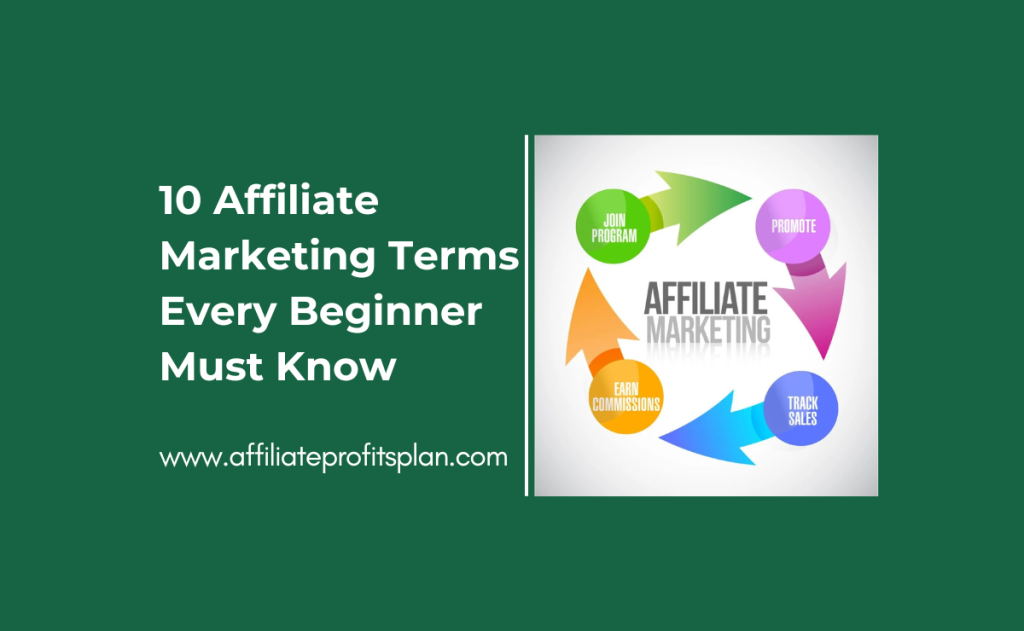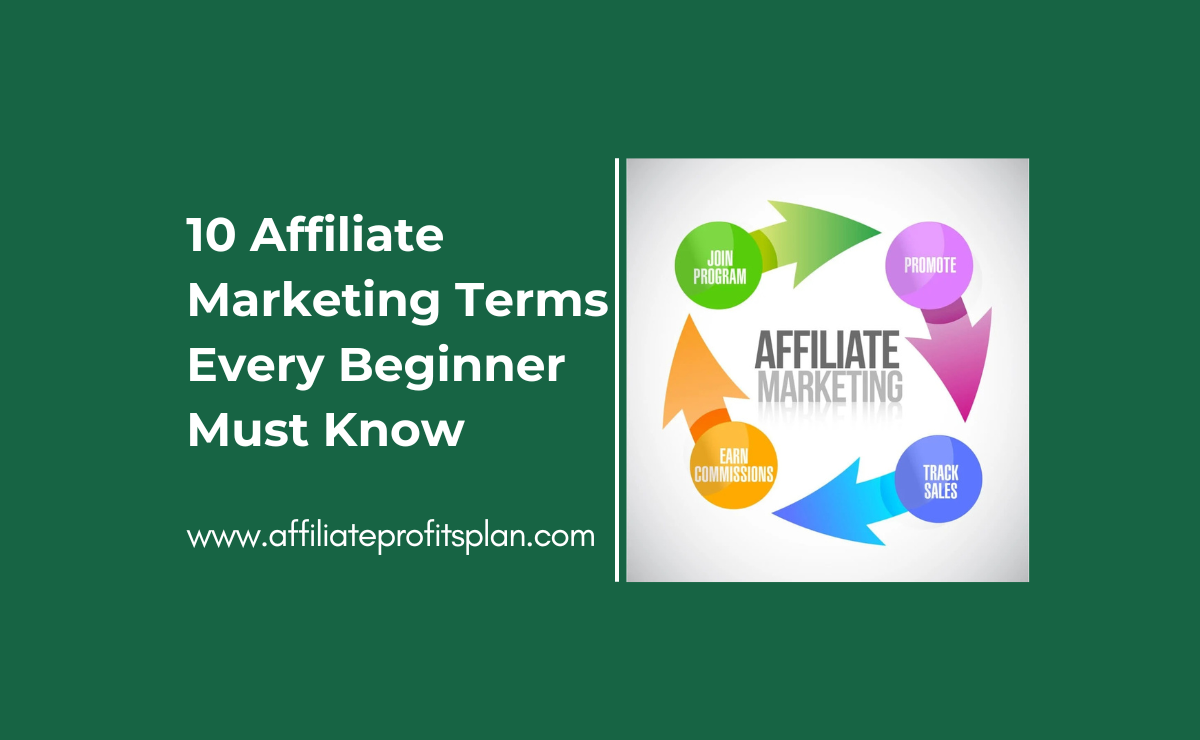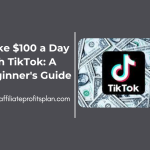Welcome to my article “10 Affiliate Marketing Terms Every Beginner Must Know” Affiliate marketing can feel like stepping into a foreign country where everyone speaks a different language. Terms like “CPC,” “CPA,” and “EPC” can make your head spin faster than an affiliate’s commission check. But fear not! Every successful affiliate marketer has been in your shoes, and learning the lingo is half the battle. In this guide, we’re going to break down the 10 essential affiliate marketing terms you absolutely need to know — no confusing jargon, no fluff — just simple, easy-to-understand definitions.
Whether you’re starting your affiliate journey or just trying to keep up with industry buzzwords, understanding these terms will give you the confidence to navigate the affiliate world. It’s like knowing the cheat codes in a video game — suddenly, everything makes sense and you can level up faster. From how you get paid (CPC, CPA, and all that fun stuff) to measuring success with metrics like conversion rate and EPC, we’ve got you covered. So, grab your notebook (or open your notes app) and let’s dive in! By the end of this article, you’ll be speaking the language of successful affiliates like a pro.
Access Our Proven Tested Formula for $50-$100 Daily Income – Watch This FREE Video >>

Understanding the Basics: Core Affiliate Marketing Terms
Before you jump headfirst into affiliate marketing, it’s important to get familiar with the core terms that will pop up every day like clockwork. These are the building blocks of affiliate marketing, and trust us, knowing these will save you from a lot of confusion (and probably a few embarrassing moments at networking events). So, let’s break them down in the simplest way possible!
Affiliate
This one’s a no-brainer! An affiliate is simply you (or the person promoting a product or service) who earns a commission by referring customers to a merchant’s product. So, when someone clicks on your affiliate link and buys a product, you get paid. It’s like being the world’s coolest middleman, except you get a sweet paycheck for your efforts.
Merchant
Now, every affiliate needs a merchant. Think of merchants as the businesses or companies behind the products or services you’re promoting. They’re the ones with the goods — you’re just the clever marketer helping them get those goods into the right hands. Whether it’s Amazon, Bluehost, or your local coffee shop, merchants provide the products and pay you for your marketing magic.
Commission
The best part! The commission is the cash you earn whenever someone buys a product through your affiliate link. The amount can vary — sometimes it’s a flat fee, and other times it’s a percentage of the sale. It’s like finding money in your pocket every time someone clicks a link, except in this case, you were the one who made it happen.
Affiliate Link
This is where it all starts. An affiliate link is a unique URL that tracks visitors who click on it and eventually make a purchase. Think of it as your personal road sign guiding potential customers to the merchant’s website. It’s your digital handshake with the merchant, saying, “I brought this customer, so let me get my fair share!”
Conversion
A conversion happens when a visitor takes the action you want them to — whether that’s making a purchase, signing up for a newsletter, or downloading an app. In simple terms: it’s when the magic happens! And the better your conversion rate, the more money you make. So, mastering this term is key to seeing your earnings grow faster than a viral meme.
By understanding these core affiliate marketing terms, you’ve just taken your first steps toward being a confident and successful affiliate. It’s like learning to ride a bike — once you’ve got the basics down, you can cruise with ease. Stay tuned for more terms in the next sections, and soon enough, you’ll be speaking affiliate fluently!
Affiliate Payment Models: How You Get Paid
Alright, now that you’re acquainted with the basics, let’s talk about the juicy stuff — how you actually get PAID in affiliate marketing. After all, you’re here to make money, right? There are different ways to earn, and understanding these payment models is crucial for planning your affiliate marketing strategy. So let’s break it down, and don’t worry, we’ll keep it simple — no confusing jargon here (unless it’s fun jargon, of course).
Cost Per Sale (CPS)
This is the granddaddy of affiliate commissions. With CPS, you get paid a percentage of the sale price whenever someone buys something through your affiliate link. The beauty of this model is that it rewards you for actual sales, not just clicks or sign-ups. So, if you’re promoting a product worth $100 and the merchant offers a 10% commission, you’re looking at a sweet $10 every time someone makes a purchase. Simple, right? Just bring in the customers and let the sales roll in!
Cost Per Click (CPC)
If you’re not in it for the long haul and prefer instant gratification, the Cost Per Click (CPC) model might be your jam. Here, you get paid whenever someone clicks on your affiliate link — even if they don’t buy anything. It’s like getting a tip just for showing up! But, here’s the thing: CPC rates are usually lower than CPS, so you’ll need a lot of clicks to see a nice payout. But, hey, clicks add up, and in the world of affiliate marketing, they can lead to sales eventually. It’s like fishing — sometimes, it takes a few nibbles before you reel in the big one.
Access Our Proven Tested Formula for $50-$100 Daily Income – Watch This FREE Video >>
Cost Per Lead (CPL)
Now, let’s talk about CPL. This payment model rewards you when someone clicks on your affiliate link and fills out a lead form — think signing up for a free trial or subscribing to a newsletter. You don’t need them to buy anything — just get them to show interest, and boom, you’re paid! It’s like being a matchmaker, getting people to say “Yes, I’m interested!” and getting a commission for your efforts. It’s all about building a potential customer list, and CPL can be a great way to monetize your audience without requiring an immediate sale.
Revenue Share
Think of revenue share like being partners with the merchant. Instead of a one-time commission, you share a percentage of the revenue generated from the sales you drive for the business over time. It’s like getting a piece of the action every time someone buys, and in some cases, even getting a cut for as long as the customer remains active with the merchant. This can be a highly lucrative model, especially if you’re promoting subscription-based services or products with repeat customers. It’s like being an affiliate for life — the gift that keeps on giving.
Cost Per Acquisition (CPA)
CPA is essentially a fancy term for getting paid when a customer takes a specific action that leads to a sale or conversion. This could mean anything from signing up for a free trial to making a full purchase. What makes CPA stand out is that the action is more specific than a simple click or sign-up. The merchant only pays you once the customer completes a predetermined goal. It’s like being rewarded for completing a mini mission. You’re setting up the stage, and once the customer performs, you cash in!
So, now you know the different ways you can earn money as an affiliate marketer. Some models might work better for certain niches, while others are all about high-volume clicks or building long-term customer relationships. The trick is figuring out which model suits your marketing style and audience. But no matter which one you choose, remember: in affiliate marketing, it’s not about making a quick buck — it’s about setting yourself up for steady, sustainable income. So pick your payment model, and start making that sweet affiliate money!
Conversion & Performance Metrics: Measuring Success
You’ve got your affiliate links out there, you’re driving traffic, and now you’re sitting back, waiting for the cash to roll in. But hold up — how do you know if you’re actually succeeding? Enter conversion and performance metrics, your new best friends. These are the numbers that’ll help you gauge whether your affiliate marketing strategy is on point or if you need to adjust your sails (don’t worry, no judgment — we all tweak our strategies).
Conversion Rate (CR)
The conversion rate is the holy grail of affiliate marketing success. It’s the percentage of visitors who click your affiliate link and actually complete the desired action — whether that’s buying a product, signing up for a newsletter, or downloading an app. You can calculate it by dividing the number of conversions (aka sales, sign-ups, etc.) by the total number of visitors who clicked your link. So, if 10 out of 100 people who clicked your link end up buying something, your conversion rate is 10%. That’s solid! Anything above 2-3% is generally considered good in affiliate marketing. A low conversion rate? Time to rethink your approach — maybe your traffic isn’t quite the right fit, or your content needs more of a nudge.
Click-Through Rate (CTR)
Think of CTR as the first step in your affiliate marketing journey. It measures how many people actually clicked on your affiliate link after seeing it. The formula is simple: divide the number of clicks by the number of times your link was shown (impressions). So, if your link got 500 views and received 50 clicks, your CTR would be 10%. A good CTR varies by industry, but a solid rule of thumb is anything above 1-2%. If your CTR is low, don’t panic — it might just be a sign you need to make your calls to action more enticing or rethink your ad copy.
Average Order Value (AOV)
AOV is your best friend when it comes to maximizing earnings. This metric measures the average amount spent by customers who make a purchase through your affiliate link. The higher the AOV, the more you earn, even if the number of sales is lower. For example, if you’re promoting high-ticket items (hello, luxury products), even a few sales can make you a lot of money. But, if you’re pushing smaller, lower-priced items, you’ll need more volume to see the same payout. A high AOV means you’re on the right track with product selection, so keep that in mind when choosing what to promote.
Cost Per Acquisition (CPA)
CPA measures how much it costs to acquire one paying customer. It’s calculated by dividing your total marketing spend by the number of conversions (i.e., paying customers). The key here is ensuring your CPA is lower than your earnings per conversion (which you’ll figure out using metrics like CPS or AOV). If your CPA is too high, you’re essentially losing money, and that’s a red flag! If you can bring down your CPA while maintaining a solid conversion rate, you’re officially in affiliate marketing nirvana.
Return on Investment (ROI)
The ROI metric is the big picture number you’ve been waiting for. It’s the amount of money you make for every dollar you spend on your affiliate marketing efforts. Calculating ROI is easy: just subtract your marketing costs from your total revenue, divide by your costs, and then multiply by 100 to get the percentage. If you’re making $200 in sales for every $100 spent, your ROI is 100%. A high ROI means you’re doing something right, and your affiliate marketing campaign is a hit. If it’s low or negative, it’s time to reevaluate how much you’re spending on ads or maybe how you’re targeting your audience.
In affiliate marketing, the numbers don’t lie. If you’re focusing on the right metrics, you’ll not only track your success but also know where to tweak and optimize to improve. Remember, it’s not just about getting traffic — it’s about getting the right traffic and converting it into sales. So, take a look at your conversion and performance metrics regularly, and use the insights to refine your strategy. Before you know it, you’ll be optimizing your way to affiliate marketing glory, one metric at a time!
Advanced Affiliate Marketing Concepts for Growth
Alright, you’ve mastered the basics of affiliate marketing, and you’re ready to take your game to the next level. This is where the fun begins (and the real cash starts rolling in). But let’s be real — affiliate marketing isn’t a “set it and forget it” type of gig. If you’re serious about scaling and growing your affiliate income, it’s time to dive into some advanced concepts. Think of this as the affiliate marketing “upgrade” — kind of like switching from a tricycle to a high-speed bike.
Access Our Proven Tested Formula for $50-$100 Daily Income – Watch This FREE Video >>
Niche Specialization
In the beginning, you might be tempted to promote anything and everything that offers a commission. But here’s the secret: niche specialization is where the magic happens. By focusing on a specific niche, you can attract a highly-targeted audience who’s genuinely interested in the products you’re promoting. And when your audience is focused, conversions skyrocket. So, let’s say you’re into eco-friendly living. Instead of promoting every random green product, focus on a handful of high-quality, sustainable products that align with your audience’s values. This deep level of specialization not only builds trust but also positions you as an authority in that niche.
Content Diversification
Gone are the days when a simple blog post or a banner ad would do the trick. To truly level up, you need to diversify your content. Video marketing, podcasts, infographics, case studies, and interactive quizzes — these aren’t just buzzwords; they’re tools that can massively increase your engagement. Imagine pairing a video review of a product with a tutorial blog post and a downloadable infographic. This approach creates multiple touchpoints, ensuring your audience encounters your affiliate links in various formats, making it much more likely for them to convert. Not to mention, video content is highly shareable, which means more eyeballs on your affiliate links.
SEO & Traffic Generation Hacks
It’s time to get nerdy with SEO, because driving organic traffic is one of the best ways to scale affiliate marketing. You’ll want to focus on keyword research to target long-tail keywords (those golden phrases people actually search for but aren’t overly competitive). But it doesn’t stop there. You also need to optimize your on-page SEO (think: titles, meta descriptions, and internal linking) and off-page SEO (backlinks, backlinks, and more backlinks). Plus, don’t sleep on technical SEO — things like site speed and mobile optimization matter more than ever. Once your content starts ranking on Google’s first page, expect your affiliate links to start generating passive income around the clock.
Email Marketing Automation
Email is still one of the most powerful tools in affiliate marketing. But here’s the kicker: automation. Setting up an automated email sequence can nurture your leads and increase conversions while you sleep. Start by collecting emails with a lead magnet (like a free e-book or exclusive webinar), and then nurture that list with a series of educational and promotional emails that include your affiliate links. The key to success here is personalization — segment your email list based on behavior (e.g., clicks, opens, purchases) to send hyper-targeted offers. A well-executed email campaign can turn a casual visitor into a loyal customer, which means more commissions in your pocket.
Building Strong Affiliate Partnerships
Affiliate marketing is all about relationships. While many affiliates focus on promoting products through networks, the real money often lies in building strong, one-on-one partnerships with affiliate managers and companies. By establishing direct relationships with merchants, you can unlock exclusive deals, higher commissions, and special bonuses. Plus, these partnerships can give you early access to new products or promotions before they hit the market. So, take the time to nurture these relationships, keep the communication flowing, and make sure both parties are benefiting. It’s like a win-win, but with extra winning.
Scaling with Paid Ads
If you’ve got the budget and you’re ready to ramp things up, paid ads can provide a significant boost to your affiliate marketing efforts. Platforms like Google Ads, Facebook Ads, and even Pinterest can put your offers in front of the right audience, fast. But here’s the trick: you need to treat paid ads as an investment, not an expense. A/B testing your ads, optimizing your landing pages, and targeting the right audience segments will help you get the most out of your ad spend. The goal? To find a winning ad campaign that delivers a solid return on investment (ROI) while you scale your affiliate marketing business.
Tracking & Analytics
You’ve heard it before: “What gets measured gets improved.” If you’re serious about scaling, you need to track everything. From click-through rates (CTR) to conversion rates, bounce rates, and more, data is your best friend. Use tools like Google Analytics, affiliate dashboards, and heatmaps to understand user behavior and tweak your strategy. Tracking allows you to identify which traffic sources are bringing in the most sales, what content resonates with your audience, and where you might be losing potential customers. The beauty of this data is that it gives you the insight you need to optimize your approach and scale your affiliate marketing business effectively.
These advanced strategies will elevate your affiliate marketing game and help you scale your efforts. Whether you’re diving deeper into a niche, automating your emails, or leveraging paid ads, the key is to keep testing, optimizing, and refining your strategies. As you grow, you’ll gain more insight into what works and what doesn’t — and that’s where the real magic happens. So, put these concepts to the test, and get ready to see your affiliate marketing business take off!
Conclusion: Putting It All Together
And there you have it — the 10 essential affiliate marketing terms you absolutely need to know as you kickstart your journey. You’ve learned about everything from traffic sources to payment models, conversion rates, and advanced growth strategies. So, what now?
Well, it’s time to put that newfound knowledge into action. Affiliate marketing isn’t some mythical beast — it’s a very real and very lucrative business model, but like any business, success doesn’t happen overnight. You’re going to encounter some bumps along the way (don’t worry, they’re totally normal), but the key is to keep learning, testing, and adapting.
Access Our Proven Tested Formula for $50-$100 Daily Income – Watch This FREE Video >>
You don’t need to become an expert in every single term we’ve covered right away. Start with the basics, understand how the concepts fit into the bigger picture, and gradually work your way up to those advanced strategies. As you go, you’ll start seeing what resonates with your audience and what drives conversions. It’s a mix of creativity, persistence, and strategy, like solving a puzzle, piece by piece.
The beauty of affiliate marketing is that the only limit to your success is how much effort you’re willing to put in. Whether you’re an absolute beginner or you’ve been at it for a while, there’s always something new to discover. And remember, you’re not alone on this journey — there’s a thriving community of affiliate marketers out there ready to share tips, strategies, and support.
So, get out there, create content that connects with your audience, test your strategies, and—most importantly—have fun while doing it! Affiliate marketing is a marathon, not a sprint. But if you stick with it and apply what you’ve learned, there’s a good chance you’ll see some serious rewards.
Good luck, and welcome to the affiliate marketing world!
Thanks a lot for reading my article on “10 Affiliate Marketing Terms Every Beginner Must Know” till the end. Hope you’ve helped. See you with another article.










